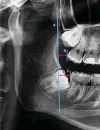Assessment of Third Molar Impaction Pattern and Associated Clinical Symptoms in a Central Anatolian Turkish Population
- PMID: 26566129
- PMCID: PMC5588352
- DOI: 10.1159/000442416
Assessment of Third Molar Impaction Pattern and Associated Clinical Symptoms in a Central Anatolian Turkish Population
Abstract
Objectives: The purpose of this study was to assess the pattern of third molar impaction and associated symptoms in a Central Anatolian Turkish population.
Material and methods: A total of 2,133 impacted third molar teeth of 705 panoramic radiographs were reviewed. The positions of impacted third molar teeth on the panoramic radiographs were documented according to the classifications of Pell and Gregory and of Winter. The presence of related symptoms including pain, pericoronitis, lymphadenopathy and trismus was noted for every patient. Distributions of obtained values were compared using the Pearson χ2 test. Nonparametric values were analyzed using the Mann-Whitney U test and Kruskal-Wallis test.
Results: The mean age of the subjects was 30.58 ± 11.98 years (range: 19-73); in a review of the 2,133 impacted third molar teeth, the most common angulation of impaction in both maxillaries was vertical (1,177; 55%). Level B impaction was the most common in the maxilla (425/1,037; 39%), while level C impaction was the most common in the mandible (635/1,096; 61%). Pain (272/705; 39%) and pericoronitis (188/705; 27%) were found to be the most common complications of impaction. Among 705 patients (335 males, 370 females), pericoronitis was more prevalent in males (101; 30%) and usually related to lower third molars (236; 22%). The retromolar space was significantly smaller in females (p < 0.05). Moreover, there was a significant difference in retromolar space for the area of jaw (maxillary: 11.3 mm; mandibular: 14.2 mm) and impaction level (A: 14.7 mm; B: 11.1 mm; C: 10.3 mm; p < 0.05).
Conclusion: The pattern of third molar impaction in a Central Anatolian Turkish population was characterized by a high prevalence rate of level C impaction with vertical position. Pain and pericoronitis were the most common symptoms usually associated with level A impaction and vertical position.
© 2015 S. Karger AG, Basel.
Figures



References
-
- Akarslan ZZ, Kocabay C. Assessment of the associated symptoms, pathologies, positions and angulations of bilateral occurring mandibular third molars: is there any similarity? Oral Surg Oral Med Oral Pathol Oral Radiol. 2009;108:e26–e32. - PubMed
-
- Polat HB, Özan F, Kara I, et al. Prevalence of commonly found pathoses associated with mandibular impacted third molars based on panoramic radiographs in a Turkish population. Oral Surg Oral Med Oral Pathol Oral Radiol. 2008;105:e41–e47. - PubMed
-
- Almendros-Marqués N, Berini-Aytés L, Gay-Escoda C. Influence of lower third molar position on the incidence of preoperative complications. Oral Surg Oral Med Oral Pathol Oral Radiol. 2006;102:725–732. - PubMed
-
- Tuzuner Oncul AM, Yazicioglu D, Alanoglu Z, et al. Postoperative analgesia in impacted third molar surgery: the role of preoperative diclofenac sodium, paracetamol and lornoxicam. Med Princ Pract. 2011;20:470–476. - PubMed
MeSH terms
LinkOut - more resources
Full Text Sources
Other Literature Sources

